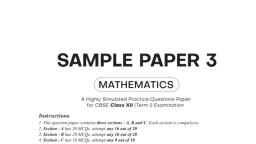Page 1 :
CLASS ~ 12 TEST TOPIC : LPP, , Corner points of the feasible region for an LPP are (0, 2), (3, 0), (6, 0),, (6, 8) and (0, 5). Let F = 4x+ 6y be the objective function. The, Minimum value of F occurs at .........., , (a) only (0, 2), , (b) only (3, 0), , (c) the mid-point of the line segment joining the points (0, 2) and (3, 0), only, , (d) any point on the line segment joining the points (0, 2) and (3, 0)., , Solution set of the inequality 2x+ y> Sis......., , (a) The half plane containing origin, , (b) The open half plane not containing origin, , (c) xy- plane excepts the points on the line 2x+ y= 5, (d) None of these, , , , The optimal value of the objective function is attained at the points........, (a) given by intersection of inequations with the axes only, , (b) given by intersection of inequations with X- axis only, , (c) given by corner points of the feasible region, , (d) None of these, , , , , , , , , , Objective function of a LPP is .........4., (a) constant graph, , (b) a function to be optimized, , (c) inequality, , (d) quadratic equation, , The maximum value of Z = x+ 4y subject to the constraints 3x+ 6y<6,, 4x+ 8y216, x 20, y =O is.........., , (a) 4, (b) 8, (c) unbounded feasible region, , (d) Does not exist feasible region
Page 2 :
The point at which the maximum value of Z = 3x+ 2y subject to the 7], constraints x+ 2y<2, x 20, y 20 is.........., , (a) (0, 0), (b) (1.5, - 1.5), (c) (2, 0), , (d) (0, 2), The feasible region of the inequality x+ y<1 and x- y<1 lies in........., quadrants., , (a) Only I and II, (b) Only I and III, (c) Only II and III, , (d) All the four, , The position of the points O(0, 0) and P(2, -1) is ........ , in the region of, the inequality 2y- 3x< 5S., , (a) O is inside the region and P is outside the region, (b) O and P both are inside the region, , (c) O and P both are outside the region, , (d) O is outside the region and P is inside the region, , , , , , , , 10, , , , The production of item A is x and the production of item B is y. If the, corner points of the bounded feasible region are (1, 0), (2, 0), (0, 2), and (0, 1) then the maximum profit z= 2000x+ 5000y is........, , (a) 20,000, , (b) 5,000, , (c) 4,000, , (d) 10,000, , The vertices of the feasible region determined by some linear constraints |, are (0, 2), (1, 1),(3, 3), (1, 5). Let Z = px+ qy where p, q> 0. The, condition on p and q so that the maximum of Z occurs at both the points, (3; 3) andi (4 8) cscnccs, , (a) p=q, , (b) p= 2q, (c) q= 2p, (d) p= 3q
Page 3 :
11, , 12, , , , 13, , , , 14, , , , 15, , The maximum value of Z = 3x+ 4y subject to constraints x+ y <4, x=0, |, We Te neces , (a) 16, , (b) 12, , (c) 0, , (d) not possible, , The shaded region in the given, figure is a graph of ........., , (a) 4x- 2y<3, (b) 4x- 2y<-3, (c) 2x- 4y23, (d) 2x- 4y<-3, , , , The feasible solution for a LPP is shown in Figure Let z = 3x - 4y be the |, objective function., (Maximum value of z +, , Minimum value of z) is equal to, , (a) 13, (b) 1, (¢) -13, (d) -17, , , , The corner points of the bounded feasible region are (0, 1), (0, 7), (2,, 7), (6, 3) (6, 0) (1, 0)., , For the objective function Z = 3x -y .........., (i) At which point, Z is minimum ?, , (ii) At which point, Z is maximum ?, , (iii) The maximum value of Z is, (iv) The minimum value of Z is, (a) (i) (2, 7) (ii) (6, 3) (ili) 20 (iv) -1, , (b) (i) (0, 7) (ii) (6, ©) (iii) 18 (iv) -7, , (c) (i) (0, 1) (ii) (6, 3) (ili) 18 (iv) -1, , (4) (i) (0, 7) (ii) (6, 0) (iii) 15 (iv) -7, , Inequation y - x < 0 represents, , (a) The half plane that contains the positive X-axis, , (b) Closed half plane above the line y = x, which contains positive Y-axis, , (c) Half plane that contains the negative X-axis, (d) None of these
Page 4 :
CASE STUDY, , , , , , 16, , , , 17, , , , , , 18, , , , , , Suppose a dealer in rural area wishes to purchase a number of sewing, machines. He has only Rs. 5760 to, invest and has space for at most 20, items for storage. An electronic, sewing machine costs him Rs. 360, and a manually operated sewing, machine Rs. 240. He can sell an, electronic sewing machine ata, profit of Rs. 22 and a manually, operated sewing machine at a, profit of Rs.18., , Based on the above information,, answer the following questions., , , , Let x and y denote the number of electronic sewing machines and, manually operated sewing machines purchased by the dealer. If it is, assumed that the dealer purchased atleast one of the given machines, then:, , (a) x+y 20, , (b) x+y <0, , (c) x+y > 0, , (d) x+y < 0, , Let the constraints in the given problem is represented by the following |, inequalities:, , x+yS20; 360x+240y<5760 and x,y20. Then which of the following, point lie in its feasible region., , (a) (0,24), , (b) (8,12), , (c) (20,2), , (d) None of these, , If the objective function of the given problem is maximize Z = 22x+18y,, then its optimal value occur at:, , (a) (0,0), , (b) (16,0), , (c) (8,12), , (d) (0,2)
Page 5 :
19, , , , , , , , Suppose the following shaded region APDO, represent the feasible, , region corresponding to mathematical formulation of the given problem., , Then which of the following represent the coordinates of one of its, corner points., , (a) (0,24), (b) (12,8), (c) (8,12), (d) (6,14), , If an LPP admits optimal solution at two consecutive vertices of a, feasible region, then, , (a) The required optimal solution is at a mid pointof the line joining two, points., , (b) The optimal solution occurs at every point on the line joining these, two points., , (c) The LPP under consideration is not solvable., , (d) The LPP under consideration must be reconstructed, , CASE STUDY, , , , A manufacturing company makes two models X and Y of a product. Each, piece of model X requires 9 labour hours for fabricating and 1 labour, hour for finishing. Each piece of model Y requires 12 labour hours of, fabricating and 3, labour hours for, finishing, the, maximum labour, hours available for, fabricating and, finishing are 180 and, 30 respectively. The, company makes a, profit of Rs. 8000 on, each piece of model X, and Rs. 12000 on each :, , piece of model Y. Assume x is the number of pieces of model X an yis, the number of pieces of model Y., , Based on the above information, answer the following questions, , , , , , , , , , Which among these is not a constraint for this LPP?, (a) 9x+12y = 180, , (b) 3x+4y < 60, , (c) x+3y < 30, , (d) None of these



















































































